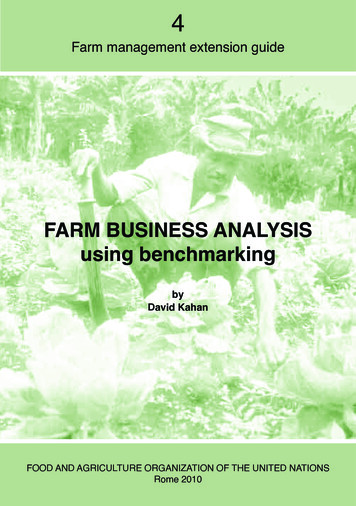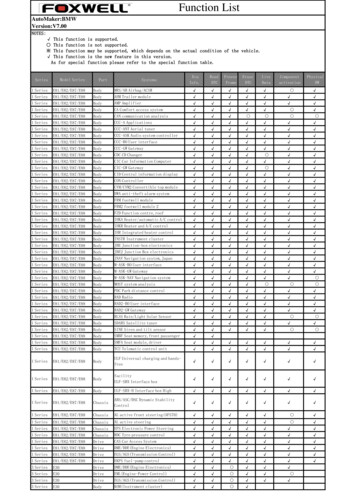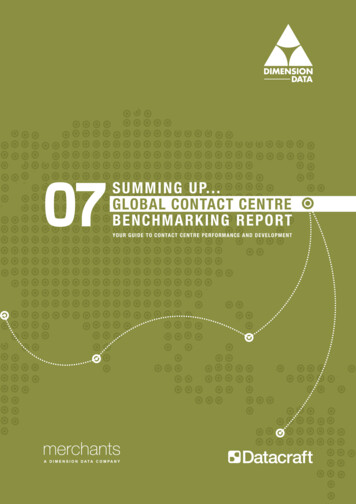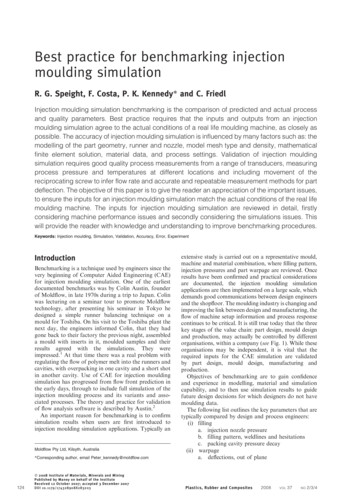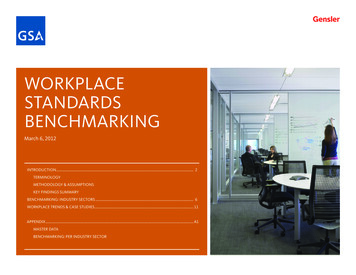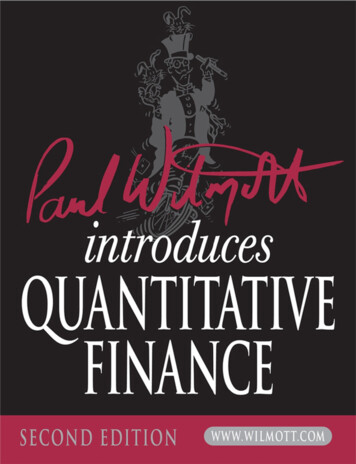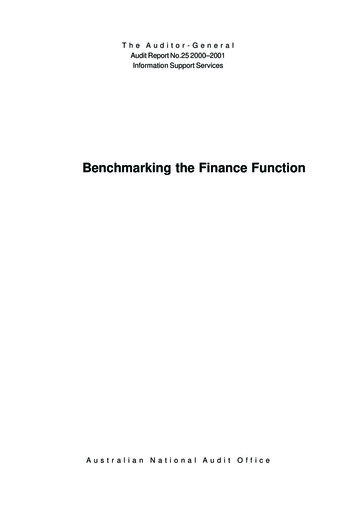
Transcription
The Auditor-GeneralAudit Report No.25 2000–2001Information Support ServicesBenchmarking the Finance FunctionAustralian National Audit Office
Commonwealthof Australia 2000ISSN 1036-7632ISBN 0 642 44274 6This work is copyright. Apart fromany use as permitted under theCopyright Act 1968, no part may bereproduced by any process withoutprior written permission from theCommonwealth, available fromAusInfo. Requests and inquiriesconcerning reproduction and rightsshould be addressed to:The Manager,Legislative Services,AusInfoGPO Box 1920Canberra ACT 2601or by email:Cwealthcopyright@dofa.gov.au2Benchmarking the Finance Function
Canberra ACT22 December 2000Dear Madam PresidentDear Mr SpeakerThe Australian National Audit Office has undertaken abenchmarking study in accordance with the authority containedin the Auditor-General Act 1997. I present this report of thisaudit, and the accompanying brochure, to the Parliament. Thereport is titled Benchmarking the Finance Function.Following its tabling in Parliament, the report will be placed onthe Australian National Audit Office’s Homepage—http://www.anao.gov.au.Yours sincerelyP. J. BarrettAuditor-GeneralThe Honourable the President of the SenateThe Honourable the Speaker of the House of RepresentativesParliament HouseCanberra ACT3
AUDITING FOR AUSTRALIAThe Auditor-General is head of theAustralian National Audit Office. TheANAO assists the Auditor-General tocarry out his duties under the AuditorGeneral Act 1997 to undertake performanceaudits and financial statement audits ofCommonwealth public sector bodies andto provide independent reports and advicefor the Parliament, the Government andthe community. The aim is to improveCommonwealth public sectoradministration and accountability.Auditor-General reports are available fromGovernment Info Shops. Recent titles areshown at the back of this report.For further information contact:The Publications ManagerAustralian National Audit OfficeGPO Box 707Canberra ACT 2601Telephone (02) 6203 7505Fax(02) 6203 7798Email webmaster@anao.gov.auANAO audit reports and informationabout the ANAO are available at ourinternet address:http://www.anao.gov.auAudit TeamEdward HayGrace GuilfoyleHayley MacGregor4Benchmarking the Finance Function
ContentsSummary, Key Findings and RecommendationSummaryKey Findings and Recommendation912Benchmark Study Findings and Conclusions1. Introduction172.Overall Finance Function BenchmarkIntroductionCost Dimension BenchmarksQuality Dimension Benchmarks232325273.Financial Budgeting and Analysis Activity BanchmarksIntroductionCost Dimension BenchmarkEfficiency Dimension BenchmarkBetter Practice BenchmarkBetter Practice Observations3131313334354.Fixed Assets Activity BenchmarksIntroductionCost Dimension BenchmarksEfficiency Dimension BenchmarkQuality Dimension BenchmarkBetter Practices Observations3737383940415.Accounts Payable Activity BenchmarksIntroductionCost Dimension BenchmarksEfficiency Dimension BenchmarksQuality Dimension BenchmarkConclusion4545464950526.‘Close the Books’ and Financial Reporting Activity BanchmarksIntroductionCost Dimension BenchmarkQuality Dimension BenchmarksConclusionBetter Practice Observations5656575859607.Accounts Receivable Activity BenchmarksIntroductionCost Dimension BenchmarksEfficiency Dimension BenchmarkQuality Dimension BenchmarksConclusionBetter Practices Observations616162646568685
8.Payroll Activity BenchmarksIntroductionCost Dimension BenchmarksEfficiency Dimension BenchmarkQuality Dimension BenchmarkConclusionBetter Practice Observations717172737477779.Travel Activity BenchmarksIntroductionCost Dimension BenchmarksEfficiency Dimension BenchmarkBetter Practice BenchmarkConclusionBetter Practice Observations8080818384858610. Billing Activity BenchmarksIntroductionCost Dimension BenchmarksQuality Dimension BenchmarksConclusionBetter Practice Observations88888890939311. Tax Activity BenchmarksIntroductionCost Dimension BenchmarkConclusionBetter Practice Observations9595959697AppendicesAppendix 1:Appendix 2:Appendix 3:Appendix 4:Benchmark Demographic ProfilesDerivation of Finance Function BenchmarksFinance Function Benchmarks1. Overall Finance Function Benchmarks2. Financial Budgeting and Analysis3. Fixed Assets Activity Benchmarks4. Accounts Payable Activity Benchmarks5. ‘Close the Books’ and Financial Reporting6. Accounts Receivable Activity Benchmarks7. Payroll Activity Benchmarks8. Travel Activity Benchmarks9. Billing Activity Benchmarks10. Tax Activity BenchmarksPrevious Audit CoverageIndexSeries TitlesBetter Practice Guides6Benchmarking the Finance 124125127
Summary, Key Findingsand Recommendations7
8Benchmarking the Finance Function
Summary1.This Report on the public sector finance function is part of a seriesof benchmarking studies being undertaken by the Australian NationalAudit Office (ANAO) into common business processes. The ANAO hasrecently published a report detailing a benchmarking study of the internalaudit function.1 and is currently undertaking a study relating to the humanresource management function. The primary purpose of these studies isto obtain and report quantitative and qualitative data on aspects ofperformance of the function or business process. The benchmark studiesare undertaken as part of the ANAO’s Information Support Services whichare also an important element of providing assurance to stakeholders.2.The objective of the finance function benchmarking study was toobtain, and report on over time, quantitative and qualitative data relatingto finance function activities as they operate in Commonwealthorganisations. 2 This Report provides the results from the first year ofthe benchmarking study. This data can be utilised by all public sectororganisations to develop appropriate measures of performance for theirown finance function as part of continuous improvement programs orbusiness re-engineering.3.While the emphasis of the ANAO benchmarking studies is to makeavailable public sector benchmarks for use as an organisationalimprovement tool, they also provide an opportunity for an across-theboard assessment of the Commonwealth public sector for particularfunctions. This assessment is based on a comparison of responses fromparticipating Commonwealth organisations (the Commonwealth Group)and data from an international group (the Global Group).4.Commonwealth organisations can compare their own performanceagainst the benchmarks and use the information to detect and diagnoseareas of concern in business processes in terms of the dimensions of cost,efficiency and quality and highlight opportunities for improvement.1Australian National Audit Office, Audit Report No.14 of 2000–01, Benchmarking the Internal AuditFunction, October 2000.2In this Report organisations refers to agencies subject to the Financial Management andAccountability (FMA) Act 1997 and statutory authorities subject to the Commonwealth Authoritiesand Companies (CAC) Act 1997.9
5.The finance function benchmarking study examines aggregatedbenchmarking measures of cost, efficiency, quality and better practicereported by nineteen Commonwealth organisations for 1998–99 andprovides aggregated benchmarking results. The Commonwealth publicsector organisations participating in the benchmark study have beenprovided with a comprehensive report comparing their results with thoseof other organisations in the Commonwealth public sector group andwith the global population.6.Ten of the Commonwealth Group organisations are covered bythe Financial Management and Accountability Act 1997 (FMA) and nine bythe Commonwealth Authorities and Companies Act 1997 (CAC).7.The Global Group used as a comparator throughout this Reportis from the Arthur Andersen benchmarking database and comprises morethan 500 organisations. The largest proportion of these organisations(45 per cent) is in the United States of America and over 95 per cent arein the private sector. Further information on the Commonwealth andGlobal benchmarking Groups is at Appendix 1.8.The ANAO study collected benchmarking data on the followingactivities: overall cost of the finance function (chapter 2); financial budgeting and analysis (chapter 3); fixed assets (chapter 4); accounts payable (chapter 5); ‘close the books’ and financial reporting (chapter 6); accounts receivable (chapter 7); payroll (chapter 8); travel (chapter 9); billing (chapter 10); and tax (chapter 11)9.The results are limited in scope to the extent that data in thestudy has been derived from self-assessments. The results do not takeaccount of, or distinguish between, the different environments in whichfinance functions operate, such as the public and private sectors. As aresult, the benchmark study can only provide a broad indication ofdifferences in performance between the two Groups.10Benchmarking the Finance Function
Summary10.Although the report makes a number of comparisons betweenthe two Groups, it is important to note that results against each of thebenchmarks should not be assessed in isolation as this rarely providesinsight into how different outcomes have been achieved. Discoveringthe specific practices responsible for high performance, and adapting andapplying them within an organisation as a basis for process improvementis not the role of this study. Thus the Report does not provide reasonsfor differences in performance, however it does provide guidance onsome of the factors that organisations may wish to consider whenevaluating their results.11
Key Findings andRecommendation11.This finance function benchmarking study indicates thatorganisations in the Commonwealth Group perform equal to or betterthan the Global Group at the median in relation to: quality in terms of lower activity error rates (accounts payable,accounts receivable and payroll); level of staffing in the finance function; making greater use of shared services; number of actual budgets; number of days between invoicing and receipt of payment; processing cost per pay, higher utilisation of direct deposit andintegrated/interfaced payroll/human resources systems; making greater use of reimbursement through payroll and directdeposit for travel payments; and some elements of activity cost (‘close the books’, accounts receivable,travel, billing and tax). It should be noted that the CommonwealthGroup perform these activities to a lesser extent than the Global Group.12.The benchmarking study also indicates that opportunities mayexist in some organisations for progress to be made in areas where theCommonwealth Group reported less favourable results overall than theGlobal Group. The main areas included are those where, at the median,there were: higher costs for the finance function overall; higher activity costs overall (budgeting and analysis, fixed assets,accounts payable, payroll, travel, and tax); higher activity cost per transaction (fixed assets, accounts payable,travel and billing); lower efficiency (budgeting and analysis, fixed assets, accountspayable, accounts receivable, payroll and travel); shorter lengths of employee service and lower levels of qualificationsfor finance function staff; and higher error rates (‘close the books’ and billing).12Benchmarking the Finance Function
Key Findings13.As previously mentioned this benchmarking study involvesmaking various comparisons between quantitative and qualititative dataderived from the Commonwealth and Global Groups. The Report doesnot attempt to provide reasons for the results. The Report does howeverprovide guidance as to the type of factors which organisations couldconsider when evaluating their results.14.The nature of this benchmarking study precludes detailedrecommendations-indeed, as discussed previously, that is not its primarypurpose. However, one broad recommendation, directed to allCommonwealth organisations, can be made.15.The ANAO recommends that organisations compare their performanceagainst the benchmarks in this Report (and any other relevant benchmarks) inorder to assist in the identification and diagnosis of areas where improvementsmay be made in their business processes.13
14Benchmarking the Finance Function
Benchmark Study Findingsand Conclusions15
16Benchmarking the Finance Function
1IntroductionBackground to the benchmarking study1.1The adoption of accrual budgeting and accounting as part of theon-going government reforms affecting the Commonwealth public sectorhas necessitated, amongst other things, the introduction of newinformation systems and enhanced management reporting by many publicsector organisations to meet the demands for better and more timelyinformation for decision making. Various reports by the ANAO havedrawn attention to the importance of having in place effective controlstructures to underpin the new budgeting and accounting framework 3.Introduction1.2The ANAO has undertaken a benchmarking study in relation tothe finance function of public sector organisations. The study is basedon data from the 1998–99 financial year, the year prior to the introductionof accrual budgeting. The results can then provide a baseline fororganisations to assess their performance in the future. While recognisingaccrual budgeting will introduce some additional complexity toorganisational budgeting, it would be reasonable to expect the currentanalysis to be improved over time as organisations streamline and improvethe integrity of their processes.1.3This Report examines measures of cost, efficiency, quality andbetter practice across a range of activities undertaken as part of the financefunction by Commonwealth government organisations. It is part of aseries of benchmarking studies being undertaken by the ANAO intocommon business processes. The primary purpose of these studies is toobtain and report quantitative and qualitative data on aspects ofperformance of the function or business process.3Australian National Audit Office Audit Report No.52 of 1999–2000 Control Structures as Part of theAudits of Financial Statements of Major Commonwealth Agencies for the Period Ended30 June 2000 and Audit Report No.21 of 1999–2000 Audits of the Financial Statements ofCommonwealth Government Agencies for the Period Ended 30 June 1999.17
1.4Comparison against benchmarks alone however, rarely providesinsight into how superior outcomes have been achieved. Discoveringthe specific practices responsible for high performance, and adapting andapplying them within an organisation provides as a basis for processimprovement is not the role of this study. Thus the Report does notprovide reasons for differences in performance. The Report doeshowever provide guidance as to some of the factors that organisationsmay wish to consider when evaluating their individual results. Whereappropriate better practice observations, drawn from ANAO betterpractice guides, the Arthur Andersen global benchmarking database andfrom Reengineering Australia, are made throughout this Report to assistorganisations in identifying opportunities for improvements.1.5Research from the private sector indicates that the operation of afinance function is regarded as expensive with significant scope forperformance improvement. Research further indicates that the financefunction in the private sector has been transformed over recent years,partly as a result of increasing cost pressures, but also in response to agrowing demand from the users of financial information for more valueadded information to assist in their decision-making.1.6As illustrated in the following diagram, better practiceorganisations are re-focussing their financial management function froma traditional base, where processing of transactions predominated,towards a lower cost, business management role.Trends in financial tion Processing18Benchmarking the Finance Function
IntroductionStudy objective1.7The objective of the benchmarking study was to obtain, over time,quantitative and qualitative benchmarks for the finance function as itoperates in Commonwealth organisations.1.8While the emphasis of the ANAO benchmarking studies is to makeavailable public sector benchmarks for use as an organisationalimprovement tool, they also provide an opportunity for an across-theboard assessment of the Commonwealth public sector for particularfunctions. This assessment is based on a comparison of responses fromparticipating Commonwealth organisations and data from an internationalgroup.Scope of the study1.9This Report includes aggregated benchmarking results fromnineteen Commonwealth organisations (the ‘Commonwealth Group’) for1998–99. Ten of the Commonwealth Group organisations are covered bythe Financial Management and Accountability Act 1997 (FMA) and nine bythe Commonwealth Authorities and Companies Act 1997 (CAC).1.10Information relating to organisational expenditure, financefunction expenditure and the number of staff in the finance function areprovided for the Commonwealth Group below.Total organisationexpenditureNumber oforganisationsFinance functionexpenditure 100 million5 1 million 100— 500 million5 1— 5 million 500 million9 5 millionTOTAL19TOTALStaff in the financesection111–25926–504TOTAL213419Number oforganisations 10 50Number oforganisations5191.11The total expenditure of the Commonwealth Group was 11.8 billion in 1998–99. The Commonwealth Group organisations allocatebetween 0.09 and 9.85 per cent of their total expenditure to the financefunction. Other activities performed by the finance area that were notcovered by the diagnostic instrument used to collect the data include19
strategic management, financial policy development, treasury, cashmanagement, devolved banking and finance help desk.1.12In order to provide the public sector organisations withbenchmarking services, the ANAO formed a strategic alliance with ArthurAndersen enabling the ANAO to access diagnostic questionnaires, globalbenchmarks and information on better practices. Data processing andanalysis was conducted jointly by the ANAO, Reengineering Australiaand Arthur Andersen.1.13The Global Group used as a comparator throughout this Reportis from the Arthur Andersen benchmarking database and comprises morethan 500 organisations. The largest proportion of these organisations(45 per cent) are in the U.S. and over 95 per cent are in the private sector.Further information on the Commonwealth and Global benchmarkingGroups is at Appendix 1.1.14The observations in this Report are based on the informationprovided by the Commonwealth Group in response to a questionnaire.Consequently, the standard of evidence relied on for the study must beconsidered persuasive, rather than conclusive, based as it is on selfassessment by organisations. These self-assessments were subject toquality assurance checks by the ANAO, but have not been audited by theANAO. Thus the quality assurance processes undertaken by the ANAOon the data are not of themselves sufficient to guarantee its integrity.1.15In most organisations data was obtained for the ‘central’ financearea only. Moreover, the benchmark information cannot take account of,or distinguish between, the different environments in which financefunctions operate, for example as between the public and private sectors.As a result, the benchmark study can only provide an insight intodifferences in performance and may raise further questions forinvestigation.Evaluation criteria1.16The diagnostic questionnaires completed by each participatingorganisation capture a wide variety of information from which the ANAOdetermined a range of benchmarks across cost, efficiency and qualitydimensions. These benchmarks—listed at Appendix 2—have been usedas the evaluation criteria for this Report. In terms of the structure of thisReport, the benchmarks have been categorised by the finance functionoverall and then each
Accounts Payable Activity Benchmarks 45 Introduction 45 Cost Dimension Benchmarks 46 Efficiency Dimension Benchmarks 49 Quality Dimension Benchmark 50 . benchmarking measures of cost, efficiency, quality and better practice report
